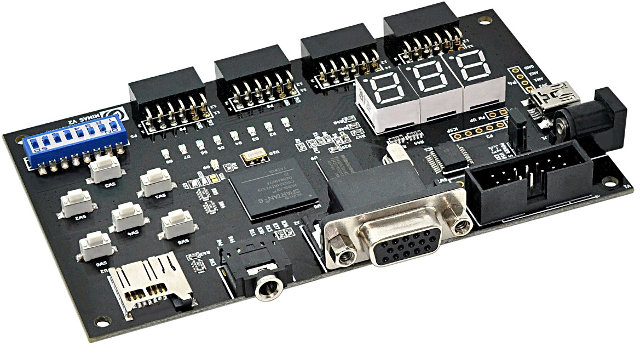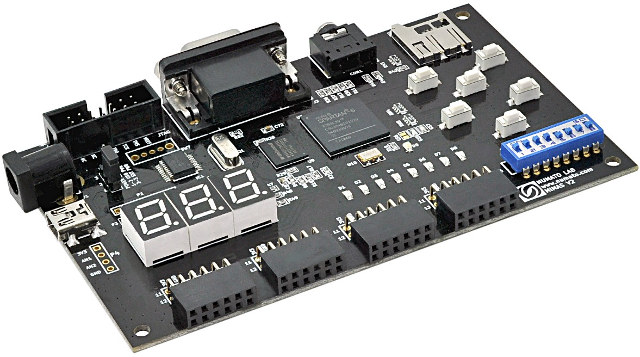Just last week, I wrote about miniSpartan3, an FPGA board powered by Xilinx Spartan 3A. It costs as low as $25, features an HDMI output port, but lacks RAM. Numato Lab’s Mimas V2 is another low cost FPGA board with a more powerful Spartan 6 FPGA, 512 Mb LPDDR memory, and instead of HDMI output, a VGA port has been included on the board. The board can be used for prototype development, signal processing, learning digital electronics and as an educational tool for schools and universities.

Technical specifications:
- FPGA – Xilinx Spartan XC6SLX9 in CSG324 package
- System Memory – 512Mb LPDDR @ 166 MHz (MT46H32M16LF/W949D6CBHX6E)
- Storage – 16 Mb SPI flash memory (M25P16) + micro SD card slot
- Video Output – VGA connector
- Audio – Stereo jack
- USB – 1x mini USB 2.0 port for on-board flash programming
- Expansion Headers – Four 6×2 header with access to 32 I/O pins, and compatible wtih Numato Lab’s add-on boards.
- Debugging / Programming – Via JTAG header or micro USB port
- Misc
- 8x LEDs, 6x Push Buttons
- 8 way DIP switch for user defined purposes.
- Three digit seven segment displays.
- Power Supply
- +5V from USB by default; External +5V power as option. Power input selected by jumper
- On-board voltage regulators for single power rail operation
- Dimensions – 120 x 73 mm
The board can be programmed with Xilinx ISE Webpack (Windows and Linux) via USB without the need for a programmer. The company also provides documentation, Verilog code samples, and several tutorials for their board, so it should be easy to get started, even for beginners. Add-on boards that can be connected via the 6×2 headers include AC97 audio codec expansion module, HDMI transmitter board, mini breadboard module, AD9283 ADC Expansion Module,and more.
The FPGA board sells for $49.95 on Amazon US, or directly on Numato Lab’s Mimas V2 product page, where you’ll also find all resources to play or work with the board.

Jean-Luc started CNX Software in 2010 as a part-time endeavor, before quitting his job as a software engineering manager, and starting to write daily news, and reviews full time later in 2011.
Support CNX Software! Donate via cryptocurrencies, become a Patron on Patreon, or purchase goods on Amazon or Aliexpress





